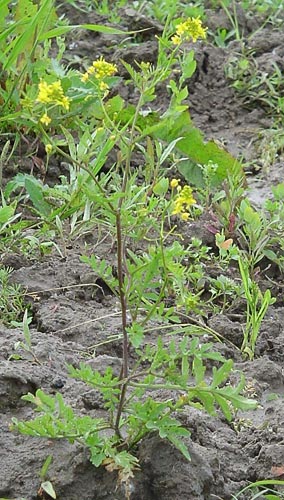Weeds
Rorippa palustris (L.) Bess. - Bog yellowcress.
Systematic position.
Family Brassicaceae Burnett (Cruciferae Juss.), genus Rorippa Scop.Synonyms.
Nasturtium palustre (L.) DC., Rorippa islandica (Oeder) Borb., Sisimbrium palustre Leyss.Biological group.
Annual or perennial weed.Morphology and biology.
Plant is glabrous or sparsely pubescent along leaf ribs. Stem is 10-70 cm in height, erect or ascending, mainly branched. Lower leaves are petiolate, lyrate. Stem leaves are sessile, auriculate, pinnatipartite with oblong, serrated lobes. Flowers are small; petals are light yellow, a little longer than sepals. Fruit is silicle. Silicles are oblong, slightly curved, swollen, with very short style and glabrous valves without ribs, a little shorter than peduncles. Seeds are horizontal, slightly flattened upward, grayish or yellowish brown, knobby, glittering on the knobs. This plant flowers and bears fruits in June-September. Seed-propagated plant. Newly ripened seeds have a germination capacity of 21%; up to 100% of seeds germinate after overwintering in soil at a depth of 2 cm. Mass seedlings appear from the end of spring until the beginning of autumn; summer and autumn seedlings overwinter.Distribution.
Occurs in the European part of the Former Soviet Union (except the Arctic), the Caucasus, Central Asia, Siberia, and the Far East. General distribution area includes moderate zones of both hemispheres.Ecology.
Plant of wet habitats. Does not prefer a specific soil type. R. palustris can grow in open plots or in semi-shady conditions.Economic significance.
R. palustris is a typical segetal weed in the zone of coniferous forests and occurs among different agricultural crops growing on very wet soil, in fallows, in vegetable gardens and gardens, and in hayfields. As a ruderal plant, it grows along banks of rivers, lakes and irrigation ditches, on sandbanks, in low-level water meadows (mostly sedge ones), in shrub thickets, in bogs, in waste places, and along roads. Young leaves of this plant can be used as food in salads; its seeds can be used as a substitute for mustard. Leaves are also used in medicine as an antiscorbutic remedy. Control measures include shallow plowing, deep autumn plowing, and timely cultivation of fallows and tilled crops as weed seedlings emerge.Related references.
Keller, B.A., ed. 1934. Weed plants of the USSR. V. 3. Leningrad: AN SSSR. 448 p. (in Russian).Komarov, V.L. & Bush, N.A., eds. 1939. Flora of the USSR. V.8. Moscow-Leningrad: USSR. 696 p. (in Russian).
Nikitin, V.V. 1983. Weed plants of the USSR flora. Leningrad: Nauka. 454 p. (in Russian).
Rorippa palustris. Plants For A Future - Species Database. 1997-2000. IBIBLIO. The public's library and digital archive: http://ibiblio.org/pfaf/cgi-bin/arr_html?Rorippa+palustris&CAN=COMIND
Shlyakova, E.V. 1982. Keys to field weed plants of Non-Chernozem zone. Leningrad: Kolos. 208 p. (in Russian).
Ulyanova, T.N. 1998. Weed plants in flora of Russia and other CIS countries. St. Petersburg: VIR. 343 p. (in Russian).


